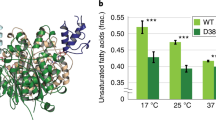Abstract
The structure ofE. coli-derived rat intestinal fatty acid-binding protein has recently been refined to 1.2 Å without bound fatty acid and to 2.0 Å and 1.75 Å with bound hexadecanoate (palmitate) and 9Z-octadecenoate (oleate), respectively. The structure ofE. coli-derived human muscle fatty acid-binding protein has also been solved to 2.1 Å with a C16 bacterial fatty acid. Both proteins contain 10 anti-parallel β-strands in a+1, +1, +1... motif. The strands are arranged in two β-pleated sheets that are orthogonally oriented. In each case, the fatty acid is enclosed by the β-sheets and is bound to the proteins by feeble forces. These feeble forces consist of (i) a hydrogen bonding network between the fatty acid's carboxylate group, ordered solvent, and side chains of polar/ionizable amino acid residues; (ii) van der Waals contacts between the methylene chain of the fatty acid and the side chain atoms of hydrophobic and aromatic residues; (iii) van der Waals interactions between the ϖ methyl and the component methenyls of the phenyl side chain of a Phe which serves as an adjustable terminal sensor situated over a surface opening or portal connecting interior and exterior solvent; and (iv) van der Waals contacts between methylenes of the alkyl chain and oxygens of ordered waters that have been located inside the binding cavity. These waters are positioned over one face of the ligand and are held in place by hydrogen bonding with one another and with the side chains of protein's polar and ionizable residues. Binding of the fatty acid ligand is associated with minimal adjustments of the positions of main chain or side chain atoms. However, acquisition of ligand is associated with removal of ordered interior solvent suggesting that the free energy of dehydration of the binding site may be as important for the energy of the binding reaction as the free energy of stabilization of the fatty acid: protein complex.
Similar content being viewed by others
References
Sacchettini JC, Gordon JI, Banaszak LJ: The crystal structure of rat intestinal fatty acid binding protein: Refinement and analysis of theE. coli-derived protein with bound palmitate. J Mol Biol 208: 327–339, 1989
Sacchettini JC, Gordon JI, Banaszak LJ: The refined structure of rat apo-intestinal fatty acid binding protein produced inE. coli. Proc Natl Acad Sci USA 86: 7736–7740, 1989
Sacchettini JC, Banaszak LJ, Gopaul D, Gordon JI: Refinement of the structure ofE. coli-derived rat intestinal binding protein with bound oleic acid to 1.75 Å: Correlation with the structures of the apoprotein and the protein with bound palmitate. J Biol Chem, in press, 1992
Scapin G, Sacchettini JC, Gordon JI: Refinement of the structure ofEscherichia coli-derived apo-rat intestinal fatty acid binding protein to 1.2 Å resolution. J Biol Chem 267: 4253–4269, 1992
Müller-Fahrnow A, Egner U, Jones TA, Ruedel H, Spener F, Saegner W: Three-dimensional structure of fatty-acid-binding protein from bovine heart. Eur J Biochem 199: 271–276, 1991
Jones TA, Bergfors T, Sedzik J, Unge T: The three-dimensional structure of P2 myelin protein. EMBO J 7: 1597–1604, 1988
Xu ZH, Bernlohr DA, Banaszak LJ: Crystal structure of recombinant murine adipocyte lipid-binding protein. Biochemistry 31: 3484–3492, 1992
Sacchettini JC, Banaszak LJ, Gordon JI: Expression of rat intestinal fatty acid binding protein inE. coli and its subsequent structural analysis: A model system for studying the molecular details of fatty acid protein interaction. Mol Cell Biochem 98: 81–93, 1990
Salemme FR: Protein crystallization by free interface diffusion. Methods Enzymol 114: 140–141, 1985
Peeters RA, Ena JM, Veerkamp JH: Expression inEscherichia coli and characterization of the fatty-acid-binding protein from human muscle. Biochem J 278: 361–364, 1991
Zanotti G, Scapin G, Spadon P, Veerkamp JH, Sacchettini JC: Three-dimensional structure of recombinant human muscle fatty acid binding protein. J Biol Chem 267: 18541–18550, 1992
Tronrud DE, Ten Eyck LF, Matthews BW: An efficient generalpurpose least-squares refinement program for macromolecular structures. Acta Cryst A 43: 489–501, 1987
Brünger AT, Kuriyan J, Karplus M: Crystallographic R factor refinement by molecular dynamics. Science 235: 458–460, 1987
Author information
Authors and Affiliations
Rights and permissions
About this article
Cite this article
Scapin, G., Young, A.C.M., Kromminga, A. et al. High resolution X-ray studies of mammalian intestinal and muscle fatty acid-binding proteins provide an opportunity for defining the chemical nature of fatty acid: protein interactions. Mol Cell Biochem 123, 3–13 (1993). https://doi.org/10.1007/BF01076469
Issue Date:
DOI: https://doi.org/10.1007/BF01076469




